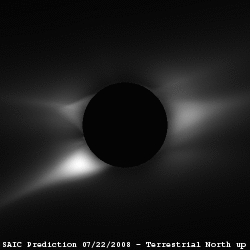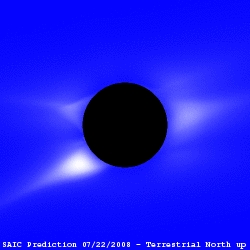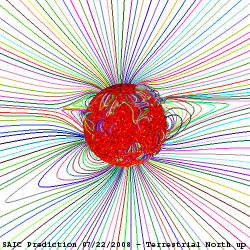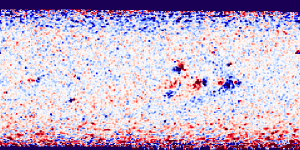During the August 1, 2008 Total Solar Eclipse
(this is the preliminary prediction posted on July 22, 2008; go here for the final prediction)
| Predicting
the Structure
of the Solar Corona During the August 1, 2008 Total Solar Eclipse (this is the preliminary prediction posted on July 22, 2008; go here for the final prediction) |
|---|
On Friday, August 1, 2008, a solar eclipse will be visible in the northern hemisphere. A total eclipse will occur within a narrow corridor starting over northern Canada, in the north polar region, and in northern Russia, western Mongolia, and China. It will be visible first near Cambridge Bay, Canada at sunrise (about 9:15 UT) and continue through Greenland, cross the Arctic Ocean, enter Russia at 10:00 UT, and terminate between Xi'an and Nanjing, China at sunset (about 11:20 UT). Maximum eclipse will occur near Nadym, in northern Siberia, north of Novosibirsk, at 10:21 UT (17:21 local time), lasting 2 minutes and 27 seconds. To see a detailed description of the eclipse path, please visit NASA's Eclipse page. For useful information about eclipse photography, please visit Fred Espenak's Eclipse web site.
On July 17, 2008, we started an
MHD computation of the solar corona,
in
preparation for our prediction
of what the solar corona would look like during this eclipse. We
used
photospheric magnetic field data measured up to July 6, 2008, by the MDI magnetograph aboard the SOHO spacecraft. We
typically also use magnetic field measurements from the Wilcox Solar Observatory
at Stanford and the National Solar Observatory SOLIS vector magnetograph at Kitt
Peak. A very useful prediction
of the photospheric solar magnetic field is carried out by Karel
Schrijver and Marc DeRosa at Lockheed
Martin.
A preliminary prediction of the state of the solar corona during the eclipse based on this data was posted on July 22, 2008, and is presented on this page. An updated (final) prediction based on updated magnetic field data measured up to July 21, 2008 was posted on July 27, 2008, and can be found here.
Our prediciton is based on a magnetohydrodynamic model of the solar
corona with improved energy transport. We used this model for the
first time to predict the structure of the corona prior to the March 29, 2006 total solar
eclipse. The improved energy equation model includes the
effects of coronal heating, the conduction of heat parallel to the
magnetic field lines, radiative losses, and the effect of Alfvén
waves. This produces a significantly better estimate of the
plasma temperature and density in the corona. For technical
details about our improved model, please see the publications
below. The prediction shown here uses our new
model, and allows
us to predict emission
in extreme ultraviolet (EUV) wavelengths and
X-rays, which can be compared with solar observations from the EIT imager on SOHO and the X-ray
instrument on Hinode,
in
addition to emission in
polarized white
light (polarization
brightness, pB) that is typically measured during an eclipse.
 |
The figure on the left shows the predicted polarization brightness (pB) in the solar corona for the eclipse expected on August 1, 2008 at 10:21 UT (corresponding to totality near Novosibirsk in Russia). The state of the solar corona was computed using a 3D magnetohydrodynamic (MHD) simulation. The pB signal is produced by white light scattered off electrons in the coronal plasma. The image has been radially detrended using the Newkirk vignetting function to account for the fall-off of coronal brightness with distance from the Sun. Vertical (top) is terrestrial (geocentric) north. This is the view of the Sun that would be seen by an observer on Earth with a camera aligned so that vertical is toward the Earth's north pole. To view this image in a coordinate system aligned with solar north, click here. Click the image to see it in greater detail. |
|---|
  |
| Predicted polarization brightness (top left) together with traces of the magnetic field lines in the solar corona (top right) for the eclipse expected on August 1, 2008 at 10:21 UT (with terrestrial north up). The Sun's surface shows color contours of the radial component of the measured photospheric magnetic field from the MDI magnetograph, showing the location of active regions (strong magnetic fields). Click the images for higher resolution pictures. To view these images in a coordinate system aligned with solar north, click here. |
| The photospheric magnetic field maps we use for our
calculations are built up from daily observations of the Sun during a
solar rotation. These maps give a good approximation of the Sun's
magnetic flux if the large-scale flux does not change much throughout a
rotation. Previously, we have computed coronal models for an
eclipse during the
declining
phase of the last solar cycle (November 3, 1994), for
three eclipses during solar minimum (October 24, 1995, March 29, 2006, and March 9, 1997), one
eclipse during the the early rising phase of solar
cycle 23 (February 26,
1998), one eclipse approaching solar maximum (August
11, 1999), and two eclipses near solar maximum (June 21, 2001 and December 4, 2002). The August 1, 2008 eclipse occurs near solar minimum, so the solar corona ought to (and does) have a simpler structure than at solar maximum. It can be seen that the solar corona is most similar to that seen in the eclipses near solar minimum on November 3, 1994, October 24, 1995, March 29, 2006, and March 9, 1997. These figures show the evolution of the radial component (Br) of the solar photospheric magnetic field for three Carrington rotations preceding the eclipse, as measured by the MDI magnetograph aboard the SOHO spacecraft. We use smoothed versions of these magnetic field maps in our calculations. We used the data for Carrington rotation (CR) 2071 in our calculation for the preliminary eclipse prediction, posted here; this calculation was started on July 17. The last panel shows the magnetic field data that was used for the final eclipse prediction. That calculation was started on July 23, 2008, and was posted on July 27, 2008; it can be found here. These maps show the radial component of the magnetic field deduced from the measured photospheric field as a function of latitude (vertical axis) and Carrington longitude (horizontal axis). Red shows outward directed magnetic field, and blue shows inward directed field. The dark regions near the top and bottom indicate areas near the solar poles where it is not possible to estimate the radial component of the magnetic field due to projection effects. Click the images for higher resolution pictures. |

|
If your movie player can continuously loop a movie while playing it, set this option to "on" for the best effect.
Z. Mikic, J. A. Linker, D. D. Schnack, R. Lionello, and A. Tarditi, "Magnetohydrodynamic Modeling of the Global Solar Corona," Physics of Plasmas, 6, 2217 (1999). Access Article
Z. Mikic, J. A. Linker, P. Riley, and R. Lionello, "Predicting the Structure of the Solar Corona During the 11 August 1999 Total Solar Eclipse," in The Last Total Solar Eclipse of the Millennium, Proceedings of the Conference held in Istanbul, Turkey, 13-15 August, 1999 (W. Livingston and A. Ozguc, eds.), ASP Conference Series, Vol. 205, p. 162 (2000). Download PDF
Z. Mikic, J. A. Linker, R. Lionello, P. Riley, and V. Titov, "Predicting the Structure of the Solar Corona for the Total Solar Eclipse of March 29, 2006," in Solar and Stellar Physics Through Eclipses (O. Demircan, S. O. Selam, and B. Albayrak, eds.), ASP Conference Series, Vol. 370, p. 299 (2007). Access Article